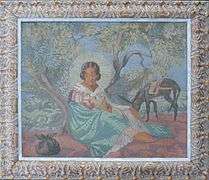Ateliers d'Art Sacré
|
Valentine Reyre, Nativité aux dominicaines | |
| Years active | 1919-1947 |
|---|---|
| Country | France |
| Major figures | Maurice Denis, Georges Desvallières |
The Ateliers d'Art Sacré (Studios of Sacred Art) was an artistic movement based in Paris in the first half of the 20th century that aimed to create church art that avoided the artificiality of traditional academic or realist work.
Foundation
The Ateliers d'Art Sacré were founded on 5 November 1919 after World War I (1914-18) by Maurice Denis (1870–1943) and Georges Desvallières (1861–1950) as part of a broad movement in Europe to reconcile the church with modern civilization.[1] Their aim was to train artists and crafts people in the practice of Christian art and to provide tasteful religious works of traditional and modern style to churches, particularly those that had been devastated by the war.[2] Denis said that he was against academic art because it sacrificed emotion to convention and artifice, and was against realism because it was prose and he wanted music. Above all he wanted beauty, which was an attribute of divinity.[3]
Activities
The artists were largely involved in decoration of the Église Saint-Esprit in Paris, where the iconography shows the milestones in church history. In this church, built in 1928-35 by the architect Paul Tournon, murals were painted by forty artists including Maurice Denis, Georges Desvallières, Henri Marret, Jean Dupa, Pauline Peugniez and Robert Poughéon. In the Way of the Cross of Saint-Michel de Picpus, decorated in 1934 under the direction of Henri de Maistre, the personality of the artists was effaced for the sake of the collaborative work.[2] The number of church commissions for the Ateliers was not enough for them to survive.[3]
The Dominican Marie-Alain Couturier (1897–1954) was a member of the Ateliers. He argued that a masterpiece, even if made by a non-believer, would always be more effective than a religious work of lesser value.[4] He gradually moved away from the influence of Maurice Denis, his master, and developed an admiration for Pablo Picasso and Henri Matisse.[3] The Canadian painter Jean Dallaire (1916–1965) was another artist who joined the Ateliers, but then became interested in Picasso and the surrealists.[5]
Examples
 Adoration of the shepherds by Maurice Denis
Adoration of the shepherds by Maurice Denis Rest in Egypt by Gabrielle Faure
Rest in Egypt by Gabrielle Faure
References
Citations
Sources
- Dekoninck, Ralph; Trémolières, François (January–March 2010). "Beauté du rite: Liturgie et esthétique dans le christianisme (XVI -XXI siècle): Présentation". Source: Revue de l'histoire des religions. Armand Colin. 227 (1 Beauté du rite: Liturgie et esthétique dans le christianisme (XVIe-XXIe siècle)). JSTOR 23618170.
- "Jean Dallaire". Musée des beaux-arts du Canada. Retrieved 2014-08-08.
- Lebée, Daniel (2014). "Les Ateliers d'Art Sacré". Ministry of Culture, France. Retrieved 2014-08-08.
- Rinuy, Paul-Louis (2002-11-07). "Le renouveau de l'art sacré dans les années 1945-1960 et la " querelle de l'art sacré "". Eduscol. Retrieved 2014-08-08.
- Rossi, Michel (2010-09-25). "Art et foi catholique au XXème siècle : les voies de la création…". Diocese of Arras. Retrieved 2014-08-08.